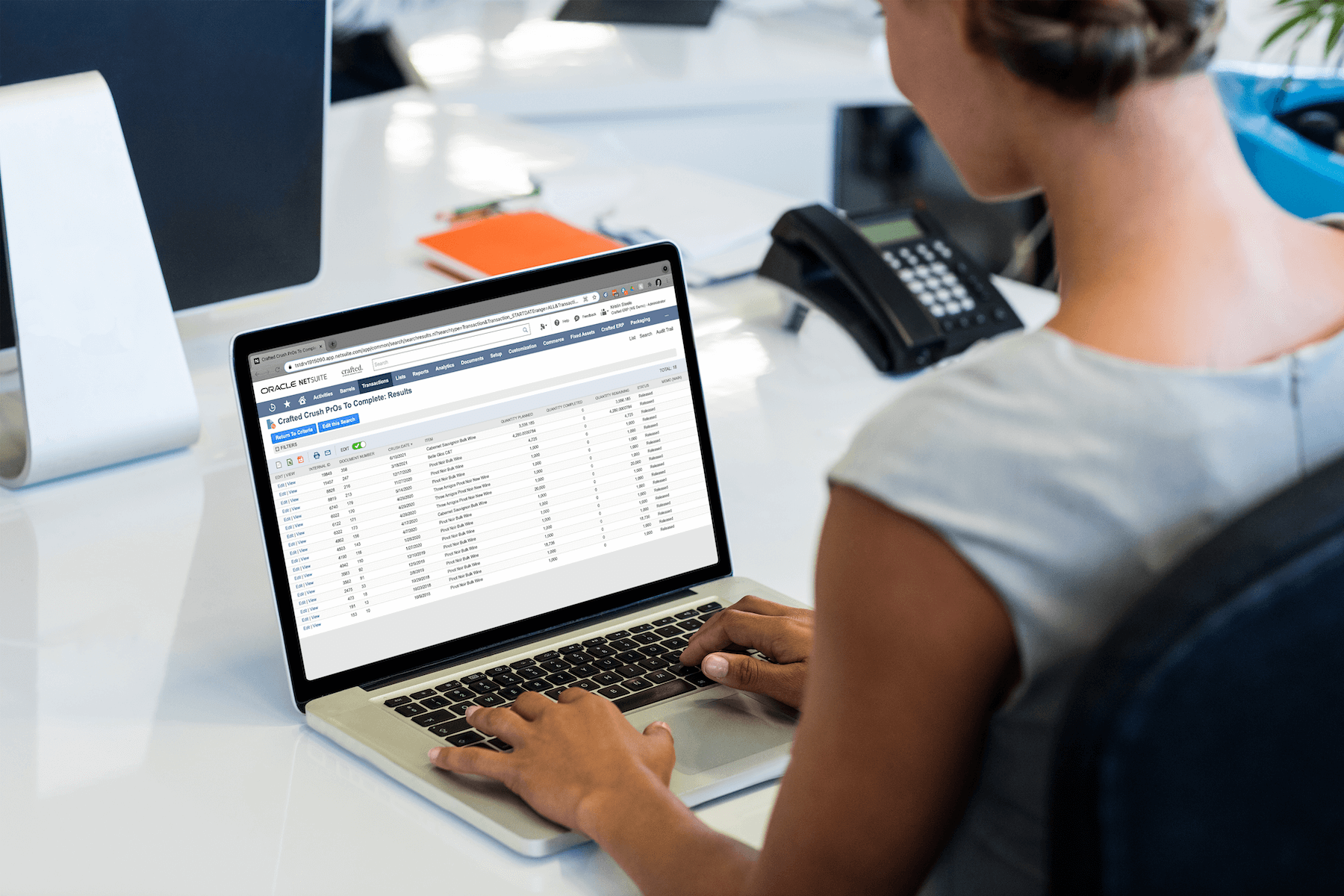Selecting and implementing beverage ERP software is a big move. It takes budget, buy-in, months of planning, process overhauls, and a whole lot of training. It’s not a light lift, but for producers in the beverage world trying to scale, streamline or simply stabilize, it’s one of the smartest investments to make. Beverage ERP increases efficiency, fixes inventory issues, simplifies compliance, and provides total visibility into what’s happening across your entire business.
If you’re an internal advocate building a business case for beverage ERP, you’re not just pitching the software you think does the best job. You’re asking leadership to fund a complete overhaul of processes and systems. You’re asking the company to take a leap from what it knows to the unknown – for a lot of money and a sometimes unknown path to ROI. Building a business case for beverage ERP requires a lot more than a vague “it’ll be better” or “this is what everyone else is doing, so we should too.”
How to Create a Business Case for Beverage ERP
This guide helps you craft a business case that doesn’t just get approved — it gets people fired up. Use this as your playbook for turning operational headaches into investment-worthy headlines.
1. Start With the Spark: What’s Broken and Bleeding?
Every ERP story starts with a trigger — the moment you realize your current system isn’t just outdated, it’s costing you money, time, talent or market share.
Maybe it’s the 17-tab spreadsheet crashing during every monthly inventory count. Or your head brewer spending more time chasing invoices than hops. Or maybe compliance is a ticking time bomb waiting to blow up your label approval process.
Here’s how to frame it in your business case for beverage ERP: “Currently, our team is managing critical operations across disconnected systems. This has led to [insert specific issues: inventory discrepancies, missed deadlines, reporting delays, etc.]. A centralized beverage ERP would streamline processes and reduce manual overhead, allowing us to scale operations and improve accuracy across departments.”
Pro tip: Don’t shy away from the pain. Expose it. Quantify it. How much have your current systems cost your company? How much will they cost your company in the future? Pain creates urgency.
2. Lead With the Goods: What Beverage ERP Will Do for You
You’re not just buying software — you’re investing in less chaos, more control and a business that can scale. Highlight the most significant wins for your business, especially those tied to your company’s strategic goals.
In your business case for beverage ERP, include specific areas for improvement like:
- Real-time inventory management: No more guesswork. Know what’s in stock, what’s aging, and what’s ready to ship.
- Simplified compliance: Track batches, manage recalls, and generate reports without breaking a sweat.
- Improved forecasting: Align production with demand and avoid stockouts and spoilage.
- Talent recruiting & retention: Younger talent expects modern tools — don’t lose great hires to ancient analog tech.
Phrase it like this: “A beverage ERP will directly support our goals to [insert your company’s goal(s), i.e., increase production, reduce waste, expand into new markets] by giving us real-time visibility across finance, inventory and compliance functions — all from a single system.”
Pro tip: Make it visceral. Replace buzzwords with impact: fewer keystrokes, faster closes, fewer fire drills.
3. Show Them the Money: ROI and Goal Tracking
If there’s one thing that will get the attention of your leadership team, it’s seeing what’s impacting the bottom line.
Break your business case for beverage ERP into numbers they can’t ignore:
- How many hours can automation save per week?
- What’s the dollar value of reducing compliance risk?
- How much could faster fulfillment increase your reorder rate?
Put it this way: “We anticipate the ERP will yield a return on investment within [X] months by reducing manual processing time by [X]%, increasing order accuracy to [X]%, and cutting compliance-related downtime by [X] hours per month.”
Track goals across three categories:
- Short-term wins: Reduced reporting time, faster inventory turns
- Mid-term gains: Improved order accuracy, reduced labor costs
- Long-term ROI: Scalability, multi-location management and smoother audits
Pro tip: Keep it focused on value creation, not just feature implementation.
4. Budget Like a Boss
Sticker shock is real. Don’t let it kill your project.
Your job? Get ahead of it by building a clear, transparent budget that breaks down:
- Licensing/subscription fees
- Implementation costs (consulting, data migration, integrations, etc.)
- Training and onboarding
- Ongoing maintenance and support
Include a buffer for unexpected costs — because they’ll come. And emphasize value over cost.
Here are some words that work: “Total estimated investment is $XXX,XXX over [X] years. We’ve included implementation, training, and a contingency of X% for unforeseen needs. We anticipate full ROI within [X] months.”
Pro tip: If leadership needs a price tag comparison, benchmark it against lost productivity, lost competitiveness or regulatory fines. Nothing makes the case like a near-miss costing $50K.
5. Map Your Champions: Who’s in the Room?
Your ERP project doesn’t move without cross-functional buy-in across the entire organization.
Lay out your stakeholder landscape:
- Executive sponsor: Signs the check and shields the project
- IT lead: Manages system integration and security
- Operations manager: Defines real-world use cases
- Finance: Tracks ROI and budget
- End users: Documents current state processes and validates daily functionality
Lead with this: “We recommend forming a cross-functional ERP implementation team that includes operations, finance, IT and leadership representation to ensure holistic alignment and adoption.”
Pro tip: Don’t just list them — anticipate their concerns. Make each one feel like the ERP is solving their biggest headache.
6. Build the Rollout Like a Campaign
You’re not flipping a switch — you’re running a transformation. Treat it like a campaign, with phases and milestones:
- Assessment: What systems and processes need replacing?
- Selection: Which ERP fits your specific beverage business needs?
- Design: What workflows need customizing?
- Implementation: Who will play major roles, and how will they be backfilled?
- Launch: Who needs training, and how will adoption be tracked?
- Support & iteration: How do you keep momentum after go-live?
These words can get you started: “The implementation will follow a phased approach over [X] months, starting with core modules like inventory and production, followed by accounting automation and MRP. Regular check-ins will track progress and adoption.”
Remember: The smoother the plan, the easier the approval.
7. Call Out the Risks (and How to Dodge Them)
Every CFO’s first question: What could go wrong?
Don’t downplay risk. Transparency = confidence. Show you’ve done your homework by naming the risks and your mitigation plan.
Drop something like this in your deck: “We’ve identified key risk areas — including change resistance and integration challenges — and developed a mitigation plan to address each. Our phased rollout ensures early testing and iterative feedback.”

The Takeaway: Your Business Case for Beverage ERP is a Sales Pitch
You’re telling a story — a before-and-after. It is a vision of your beverage company running leaner, faster and smarter.
So pitch it like that.
Make the pain points hurt. Make the future sound frictionless. Use numbers that stick, language that clicks, and structure that sells. Because at the end of the day, this isn’t about software. It’s about building a business that pours smoother, grows faster, and wins bigger.
It starts here. You’ve got the pain points. We’ve got the system, ROI and rollout plan to help your team say “We’re ready to go!” Let’s chat!







